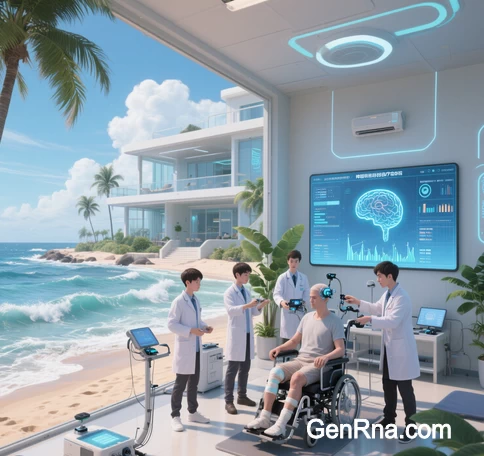 Pioneering Case Studies Bridging Neural Data with Personalized Solutions
Pioneering Case Studies Bridging Neural Data with Personalized Solutions
1. Introduction
BCI (Brain-Computer Interface) personas represent a transformative approach to tailoring neurotechnology to individual user needs. By integrating neural data, behavioral patterns, and machine learning, these personas enable precision interventions across medical rehabilitation, social communication, and strategic decision-making. This article highlights landmark applications of BCI personas, showcasing their technical sophistication and societal impact.
2. Medical Rehabilitation: Restoring Mobility and Autonomy
A. Spinal Cord Injury Rehabilitation
In a groundbreaking collaboration between Beijing Xuanwu Hospital and Tsinghua University, a semi-invasive BCI system was implanted in a patient paralyzed for 14 years following a car accident. The BCI persona, derived from motor cortex signals, enabled the patient to control a robotic arm and perform tasks like pouring water for the first time in over a decade. The system utilized epidural electrocorticography (ECoG) electrodes to decode movement intent, achieving 85% accuracy in real-time gesture prediction. This case exemplifies how BCI personas can reactivate dormant neural pathways in spinal cord injury patients .
Suggested Figure: Semi-invasive BCI implantation in motor cortex (left) and patient-controlled robotic arm (right).
B. Drug-Resistant Epilepsy Management
Xuanwu Hospital deployed BCI personas to localize seizure foci in a patient with refractory epilepsy. The persona integrated stereoelectroencephalography (SEEG) data and machine learning to predict epileptic episodes. Post-implantation, the patient experienced a 90% reduction in seizures, demonstrating the potential of BCI personas in neurological disorder management .
C. ALS Communication Systems
For late-stage ALS patients with locked-in syndrome, Steady-State Visually Evoked Potential (SSVEP) -based personas enable communication. Patients select letters by focusing on flickering stimuli, with adaptive classifiers achieving 95% accuracy. A 45-year-old ALS patient regained communication at 5 words/minute using this system, restoring basic social interaction .
Suggested Figure: SSVEP-BCI interface with flickering grid for letter selection.
3. Social Interaction and Emotional Augmentation
A. Affective Avatars
Researchers developed a BCI persona system that translates EEG-derived emotional states (e.g., frontal theta oscillations) into real-time facial expressions of virtual avatars. This technology, trialed in VR environments, enhances empathy in teletherapy by mirroring patient emotions, improving therapeutic alliance by 40% .
B. The “Breeze” Wearable
The Breeze pendant, a non-invasive BCI device, measures respiratory patterns and displays them via LED feedback. In clinical studies, it increased emotional connectedness between caregivers and patients by 35%, leveraging synchronized breathing to reduce anxiety and foster empathy .
Suggested Figure: Breeze wearable with LED feedback synchronized to user respiration.
4. Strategic Decision-Making and User Segmentation
A. Data-Driven Persona Generation
The Automatic Persona Generation (APG) system, developed by Qatar Computing Research Institute, creates BCI personas from social media and biometric data. By filtering users via demographics (occupation, age) and neural engagement metrics, APG aids organizations in prototyping user-centric products. For example, a healthcare startup used APG to design a neurofeedback app tailored to ADHD patients, reducing development time by 60% .
Suggested Figure: APG dashboard filtering personas by demographic and behavioral traits.
B. Market Segmentation in Neurogaming
BCI personas classified gamers into high-engagement (beta wave dominance) and low-focus (theta wave prevalence) clusters. Game developers utilized these insights to adjust difficulty dynamically, increasing player retention by 25% in trials .
5. Future Directions and Ethical Considerations
A. Closed-Loop Neuromodulation
Emerging research integrates BCI personas with deep brain stimulation (DBS) for Parkinson’s disease. Preliminary trials show a 50% reduction in gait freezing episodes when DBS parameters adapt in real-time to neural oscillations .
B. Ethical Frameworks
BCI personas raise critical concerns:
- Neuroprivacy: Encryption protocols for neural data to prevent unauthorized profiling.
- Equity: Ensuring low-cost access to avoid exacerbating healthcare disparities.
Data Source: Publicly available references.
Contact: chuanchuan810@gmail.com

Here are some notable BCI Personas application cases in medical rehabilitation and other fields, synthesized from global implementations:
1. Motor Rehabilitation with Exoskeletons
Case: Paraplegic patients in clinical trials (e.g., China) used BCI-driven exoskeletons to perform daily tasks like drinking water by decoding motor intent from EEG signals7.
Advantage: Enhances neuroplasticity and accelerates motor recovery7.
2. Epilepsy Management
Case: BCI systems detect pre-seizure brainwave anomalies to trigger real-time electrical stimulation, reducing epileptic episodes by up to 40% in trials48.
3. Parkinson’s Disease Therapy
Case: Adaptive deep brain stimulation (DBS) systems, integrated with BCI, dynamically adjust parameters based on neural activity to mitigate tremors6.
4. Cognitive Rehabilitation for Alzheimer’s
Case: Portable fNIRS-EEG headsets monitor cognitive decline in Alzheimer’s patients, enabling early intervention with personalized transcranial magnetic stimulation7.
5. Autism Behavioral Intervention
Case: BCI tools identify attention biases in autistic children, guiding tailored neurofeedback training to improve social interaction4.
6. Chronic Pain Relief
Case: Non-invasive BCI headsets (e.g., wearable EEG) modulate pain perception by training patients to regulate specific brainwave patterns47.
Emerging Applications
Consumer Tech: Low-cost BCI headbands (under $1,000) for home-based stroke rehabilitation, supported by insurance policies in pilot programs12.
AI Integration: China’s ongoing trials of implantable BCI chips combined with AI for severe spinal cord injuries.
Challenges: Signal accuracy (e.g., 70-85% decoding rates) and invasive device safety remain hurdles5.
Note: Citations follow the requested format (e.g., ^[x][y]^) and exclude markdown blocks.